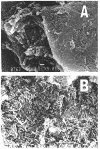Pseudomonas aeruginosa and the oropharyngeal ecosystem of tube-fed patients
- PMID: 12967493
- PMCID: PMC3020605
- DOI: 10.3201/eid0908.030054
Pseudomonas aeruginosa and the oropharyngeal ecosystem of tube-fed patients
Abstract
We evaluated whether elderly patients fed with nasogastric tubes (NGT) are predisposed to Pseudomonas aeruginosa colonization in the oropharynx. Fifty-three patients on NGT feeding and 50 orally fed controls with similar clinical characteristics were studied. The tongue dorsum was swabbed and cultured. P. aeruginosa was isolated in 18 (34%) of the NGT-fed group but in no controls (p<0.001). Other gram-negative bacteria were cultured from 34 (64%) of NGT-fed patients as compared with 4 (8%) of controls (p<0.001). Antibiotic susceptibility of the oropharyngeal P. aeruginosa isolates was compared with that of isolates from sputum cultures obtained from our hospital's bacteriologic laboratory. The oropharyngeal isolates showed a higher rate of resistance; differences were significant for amikacin (p<0.03). Scanning electron microscope studies showed a biofilm containing P. aeruginosa organisms. The pulsed-field gel electrophoresis profile of these organisms was similar to that of P. aeruginosa isolates from the oropharynx. NGT-fed patients may serve as vectors of resistant P. aeruginosa strains.
Figures



Similar articles
-
Saliva secretion and oral flora in prolonged nasogastric tube-fed elderly patients.Isr Med Assoc J. 2003 May;5(5):329-32. Isr Med Assoc J. 2003. PMID: 12811948
-
Biodynamics of biofilm formation on nasogastric tubes in elderly patients.Isr Med Assoc J. 2005 Jul;7(7):428-30. Isr Med Assoc J. 2005. PMID: 16011056
-
Pathogenic colonization of the stomach in enterally fed elderly patients: Comparing percutaneous endoscopic gastrostomy with nasogastric tube.J Am Geriatr Soc. 2006 Dec;54(12):1905-8. doi: 10.1111/j.1532-5415.2006.00964.x. J Am Geriatr Soc. 2006. PMID: 17198497 Clinical Trial.
-
Pseudomonas aeruginosa chromosomal beta-lactamase in patients with cystic fibrosis and chronic lung infection. Mechanism of antibiotic resistance and target of the humoral immune response.APMIS Suppl. 2003;(116):1-47. APMIS Suppl. 2003. PMID: 14692154 Review.
-
Risk assessment of Pseudomonas aeruginosa in water.Rev Environ Contam Toxicol. 2009;201:71-115. doi: 10.1007/978-1-4419-0032-6_3. Rev Environ Contam Toxicol. 2009. PMID: 19484589 Review.
Cited by
-
Percutaneous endoscopic gastrostomy versus nasogastric feeding in older individuals with non-stroke dysphagia: a systematic review.J Nutr Health Aging. 2015 Feb;19(2):190-7. doi: 10.1007/s12603-014-0527-z. J Nutr Health Aging. 2015. PMID: 25651445
-
Staphylococcus aureus colonization in the nasopharynx of nasogastric tube-fed patients in a long-term care facility.Eur J Clin Microbiol Infect Dis. 2009 Sep;28(9):1147-9. doi: 10.1007/s10096-009-0747-z. Epub 2009 May 13. Eur J Clin Microbiol Infect Dis. 2009. PMID: 19437051
-
Oral colonisation by antimicrobial-resistant Gram-negative bacteria among long-term care facility residents: prevalence, risk factors, and molecular epidemiology.Antimicrob Resist Infect Control. 2020 Mar 4;9(1):45. doi: 10.1186/s13756-020-0705-1. Antimicrob Resist Infect Control. 2020. PMID: 32131899 Free PMC article.
-
Proteomic Response of Pseudomonas aeruginosa PAO1 Adhering to Solid Surfaces.Front Microbiol. 2017 Aug 3;8:1465. doi: 10.3389/fmicb.2017.01465. eCollection 2017. Front Microbiol. 2017. PMID: 28824592 Free PMC article.
-
A score to predict Pseudomonas aeruginosa infection in older patients with community-acquired pneumonia.BMC Infect Dis. 2023 Oct 19;23(1):700. doi: 10.1186/s12879-023-08688-w. BMC Infect Dis. 2023. PMID: 37858082 Free PMC article.
References
-
- Leibovitz A, Plotnikov G, Habot B, Rosenberg M, Segal R. Pathogenic colonization of the oral flora in frail elderly patients fed by naso-gastric tube or percutaneous entero-gastric tube. J Gerontol Biol Sci Med Sci. 2003;58A:52–5. - PubMed
-
- Pollack M. Pseudomomas aeruginosa. In: Mandell GL, Bennett JE, Dolin R, editors. Principles and practice of infectious disease. Edinburgh: Churchill Livingstone, Ltd; 2000.
MeSH terms
LinkOut - more resources
Full Text Sources
